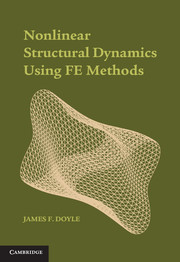Refine search
Actions for selected content:
8125 results in Fluid dynamics and solid mechanics
Frontmatter
-
- Book:
- Nonlinear Structural Dynamics Using FE Methods
- Published online:
- 05 October 2014
- Print publication:
- 06 October 2014, pp i-iv
-
- Chapter
- Export citation
2 - Dynamics of Discretized Systems
- from PART I - MECHANICS AND MODELS
-
- Book:
- Nonlinear Structural Dynamics Using FE Methods
- Published online:
- 05 October 2014
- Print publication:
- 06 October 2014, pp 54-91
-
- Chapter
- Export citation
8 - Vibration of Plates and Shells
- from PART II - DYNAMIC ANALYSES
-
- Book:
- Nonlinear Structural Dynamics Using FE Methods
- Published online:
- 05 October 2014
- Print publication:
- 06 October 2014, pp 427-486
-
- Chapter
- Export citation
10 - Stability of the Motion
- from PART II - DYNAMIC ANALYSES
-
- Book:
- Nonlinear Structural Dynamics Using FE Methods
- Published online:
- 05 October 2014
- Print publication:
- 06 October 2014, pp 538-598
-
- Chapter
- Export citation
6 - Modal Analysis of Large Systems
- from PART II - DYNAMIC ANALYSES
-
- Book:
- Nonlinear Structural Dynamics Using FE Methods
- Published online:
- 05 October 2014
- Print publication:
- 06 October 2014, pp 343-384
-
- Chapter
- Export citation
7 - Vibration of Rods and Beams
- from PART II - DYNAMIC ANALYSES
-
- Book:
- Nonlinear Structural Dynamics Using FE Methods
- Published online:
- 05 October 2014
- Print publication:
- 06 October 2014, pp 385-426
-
- Chapter
- Export citation
3 - Modeling Elastic Structures
- from PART I - MECHANICS AND MODELS
-
- Book:
- Nonlinear Structural Dynamics Using FE Methods
- Published online:
- 05 October 2014
- Print publication:
- 06 October 2014, pp 92-205
-
- Chapter
- Export citation
4 - Modeling Applied Loads
- from PART I - MECHANICS AND MODELS
-
- Book:
- Nonlinear Structural Dynamics Using FE Methods
- Published online:
- 05 October 2014
- Print publication:
- 06 October 2014, pp 206-270
-
- Chapter
- Export citation
Contents
-
- Book:
- Nonlinear Structural Dynamics Using FE Methods
- Published online:
- 05 October 2014
- Print publication:
- 06 October 2014, pp vii-x
-
- Chapter
- Export citation
Dedication
-
- Book:
- Nonlinear Structural Dynamics Using FE Methods
- Published online:
- 05 October 2014
- Print publication:
- 06 October 2014, pp v-vi
-
- Chapter
- Export citation
PART I - MECHANICS AND MODELS
-
- Book:
- Nonlinear Structural Dynamics Using FE Methods
- Published online:
- 05 October 2014
- Print publication:
- 06 October 2014, pp 5-6
-
- Chapter
- Export citation
Notation
-
- Book:
- Nonlinear Structural Dynamics Using FE Methods
- Published online:
- 05 October 2014
- Print publication:
- 06 October 2014, pp xi-xiv
-
- Chapter
- Export citation
1 - Dynamics of Simple Elastic Systems
- from PART I - MECHANICS AND MODELS
-
- Book:
- Nonlinear Structural Dynamics Using FE Methods
- Published online:
- 05 October 2014
- Print publication:
- 06 October 2014, pp 7-53
-
- Chapter
- Export citation
Index
-
- Book:
- Nonlinear Structural Dynamics Using FE Methods
- Published online:
- 05 October 2014
- Print publication:
- 06 October 2014, pp 619-622
-
- Chapter
- Export citation
9 - Wave Propagation
- from PART II - DYNAMIC ANALYSES
-
- Book:
- Nonlinear Structural Dynamics Using FE Methods
- Published online:
- 05 October 2014
- Print publication:
- 06 October 2014, pp 487-537
-
- Chapter
- Export citation
References
-
- Book:
- Nonlinear Structural Dynamics Using FE Methods
- Published online:
- 05 October 2014
- Print publication:
- 06 October 2014, pp 613-618
-
- Chapter
- Export citation
PART II - DYNAMIC ANALYSES
-
- Book:
- Nonlinear Structural Dynamics Using FE Methods
- Published online:
- 05 October 2014
- Print publication:
- 06 October 2014, pp 341-342
-
- Chapter
- Export citation
Introduction
-
- Book:
- Nonlinear Structural Dynamics Using FE Methods
- Published online:
- 05 October 2014
- Print publication:
- 06 October 2014, pp 1-4
-
- Chapter
- Export citation
5 - Computational Methods
- from PART I - MECHANICS AND MODELS
-
- Book:
- Nonlinear Structural Dynamics Using FE Methods
- Published online:
- 05 October 2014
- Print publication:
- 06 October 2014, pp 271-340
-
- Chapter
- Export citation

Nonlinear Structural Dynamics Using FE Methods
-
- Published online:
- 05 October 2014
- Print publication:
- 06 October 2014
